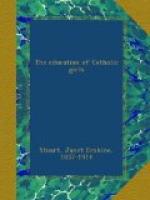2. That even if the facts were still more authentic to justify personal attacks on some of the popes, even if the abuses in the Church had not been grossly exaggerated, even putting facts at their worst, granting all that is assumed, it tends to strengthen faith rather than to undermine it, for the existence of the Church and the Papacy as they are to-day is a wonder only enhanced by every proof that it ought to have perished long ago according to all human probability. With that confidence and assurance even our little girls may hold their heads high, with their faith and trust in the Church quite unabashed, and wait for an answer if they cannot give it to others or to themselves at the moment. “We have no occasion to answer thee concerning this matter,” said the three holy children to Nabuchodonosor, and so may our own children say if they are hard pressed, “your charges do but confirm our faith, we have no occasion to answer.”
It is impossible to leave so great a subject as history without saying a word on the manner of teaching it (for in this a manner is needed rather than a method), when it is emancipated from the fetters of prescribed periods and programmes which attach it entirely to text-books. Text-books are not useless but they are very hard to find, and many Catholic text-books, much to be desired, are still unwritten, especially in England. America has made more effort in this direction than we. But the strength of historical teaching for children and girls at school lies in oral lessons, and of these it would seem that the most effective form is not the conversational lesson which is so valuable in other subjects, nor the formal lesson with “steps,” but the form of a story for little ones; for older children the narrative leading up to a point of view, with conversational intervals, and encouragement for thoughtful questions, especially at the end of the lesson; and in the last years an informal kind of lecture, a transition from school-room methods to the style of formal lectures which maybe attended later.
Lessons in history are often spoiled by futile questions put in as it were for conscience’ sake, to satisfy the obligation of questioning, or to rouse the flagging attention of a child, but this is too great a sacrifice. It is artistically a fault to jar the whole movement of a good narrative for the sake of running after one truant mind. It is also artistically wrong and jarring to go abruptly from the climax of a story, or narrative, or lecture which has stirred some deep thought or emotion, and call with a sudden change of tone for recapitulation, or summary, or discussion. Silence is best; the greater lessons of history ought to transcend the limits of mere lessons, they are part of life, and they tell more upon the mind if they are dissociated from the harness and trappings of school work. Written papers for younger students and essays for seniors are the best means of calling for their results, and of guiding the line of reading by which all oral teaching of history and study of text-books must be supplemented.




